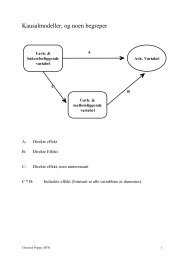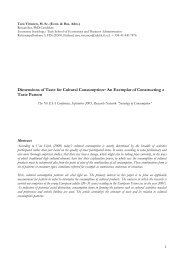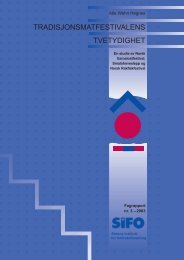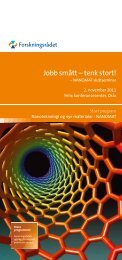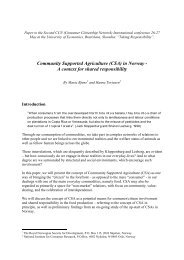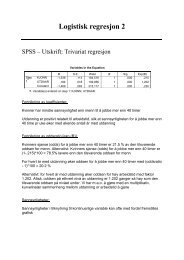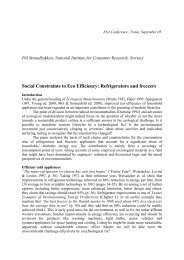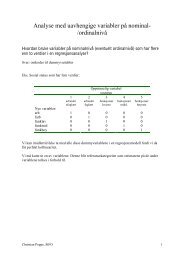Last ned i fulltekst - Sifo
Last ned i fulltekst - Sifo
Last ned i fulltekst - Sifo
Create successful ePaper yourself
Turn your PDF publications into a flip-book with our unique Google optimized e-Paper software.
Summary<br />
All links in the meat product distribution channel in this study have gone<br />
through processes to make them more efficient during the period that we<br />
study. We therefore had reason to expect changes in the price margins in our<br />
results. It was of course difficult to isolate the effect of individual changes.<br />
In addition, the entire food system had to handle the changes in the consumption<br />
of meat. The development in the consumption of beef and pork showed a<br />
strong growth from the 50s, but in the last few years, there has been stagnation<br />
in the growth and/or reduction in consumption. At the same time, the food<br />
system as a whole has been under certain pressure because the share of the<br />
household budget used on food has been decreasing over time.<br />
Methods and data sources<br />
This project had ready-made single commodities in the shop as the starting<br />
point. We have estimated margins for every link in the distribution channel for<br />
selected single commodities. The results of the margin estimates will mainly<br />
be presented as larger groups of meat products, that is as cut parts, steaks<br />
and minces of beef and pork, and as processed products such as sausages<br />
and cold cuts.<br />
We have chosen to split the value chain or the distribution channel into different<br />
links that reflect various functions. The gross margin was estimated for<br />
every link, with a single commodity as the starting point. The gross margin is<br />
the difference between selling price and purchasing price. In addition, we adjusted<br />
for taxes and government subsidies. The result was an adjusted gross<br />
margin, which from now on will be called a ‘margin’. When estimating margins,<br />
we have adjusted the need for raw materials in relation to wastage in the<br />
production process, and we have distributed the costs of raw materials when<br />
dealing with co-productions of products.<br />
To be able to estimate margins, reliable price registrations between each of<br />
the links in the distribution channel are needed. In addition, the relevant taxes<br />
and subsidies must be determi<strong>ned</strong>. The margin estimates on meat products<br />
are based on observed prices for single items during the period 1989-99, and<br />
show the margins in nominal NOK. Margin percentages for the links in the<br />
distribution channel for single commodities were also estimated. We have<br />
chosen to do this in two ways, as the margin’s share of the total margin and<br />
as the margin’s share of the retailer price for the selected commodities. This is<br />
a better source for comparing margins over time, as these show the change in<br />
per cent for each link’s margin over time. It is thus possible to look at the relative<br />
development of margin sizes within the distribution channel of single<br />
commodities, without inflation influencing the results. We have put the main<br />
emphasis on presenting the development in the shares based on the margins<br />
as shares of the total of the margins. We then exami<strong>ned</strong> the distribution of<br />
income in the sales channel, adjusted for taxes and subsidies.<br />
15




